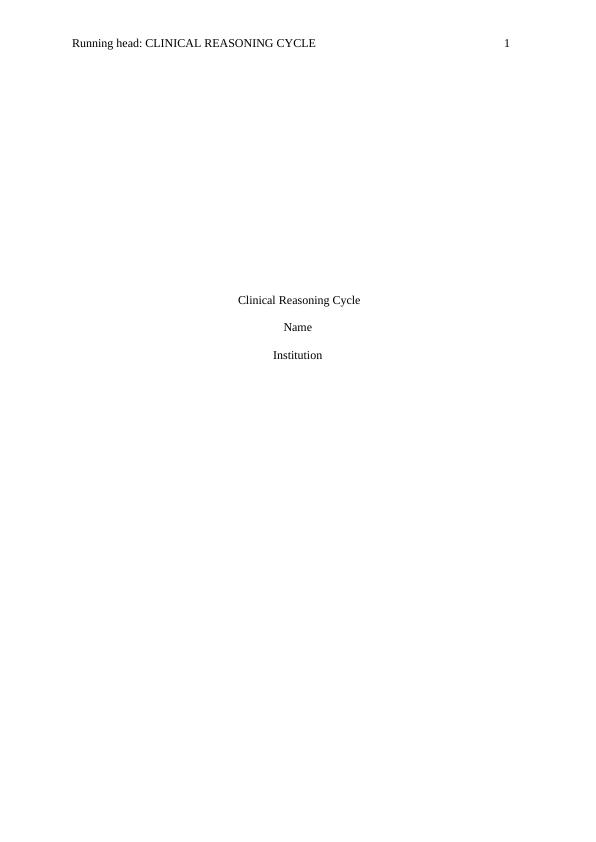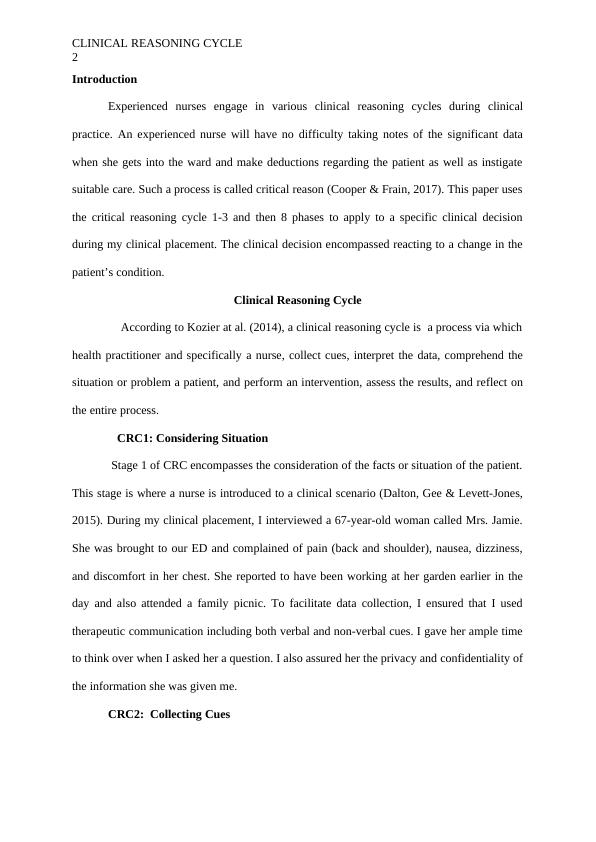Clinical Reasoning Cycle
Added on 2023-01-12
6 Pages1561 Words88 Views
Running head: CLINICAL REASONING CYCLE 1
Clinical Reasoning Cycle
Name
Institution
Clinical Reasoning Cycle
Name
Institution

CLINICAL REASONING CYCLE
2
Introduction
Experienced nurses engage in various clinical reasoning cycles during clinical
practice. An experienced nurse will have no difficulty taking notes of the significant data
when she gets into the ward and make deductions regarding the patient as well as instigate
suitable care. Such a process is called critical reason (Cooper & Frain, 2017). This paper uses
the critical reasoning cycle 1-3 and then 8 phases to apply to a specific clinical decision
during my clinical placement. The clinical decision encompassed reacting to a change in the
patient’s condition.
Clinical Reasoning Cycle
According to Kozier at al. (2014), a clinical reasoning cycle is a process via which
health practitioner and specifically a nurse, collect cues, interpret the data, comprehend the
situation or problem a patient, and perform an intervention, assess the results, and reflect on
the entire process.
CRC1: Considering Situation
Stage 1 of CRC encompasses the consideration of the facts or situation of the patient.
This stage is where a nurse is introduced to a clinical scenario (Dalton, Gee & Levett-Jones,
2015). During my clinical placement, I interviewed a 67-year-old woman called Mrs. Jamie.
She was brought to our ED and complained of pain (back and shoulder), nausea, dizziness,
and discomfort in her chest. She reported to have been working at her garden earlier in the
day and also attended a family picnic. To facilitate data collection, I ensured that I used
therapeutic communication including both verbal and non-verbal cues. I gave her ample time
to think over when I asked her a question. I also assured her the privacy and confidentiality of
the information she was given me.
CRC2: Collecting Cues
2
Introduction
Experienced nurses engage in various clinical reasoning cycles during clinical
practice. An experienced nurse will have no difficulty taking notes of the significant data
when she gets into the ward and make deductions regarding the patient as well as instigate
suitable care. Such a process is called critical reason (Cooper & Frain, 2017). This paper uses
the critical reasoning cycle 1-3 and then 8 phases to apply to a specific clinical decision
during my clinical placement. The clinical decision encompassed reacting to a change in the
patient’s condition.
Clinical Reasoning Cycle
According to Kozier at al. (2014), a clinical reasoning cycle is a process via which
health practitioner and specifically a nurse, collect cues, interpret the data, comprehend the
situation or problem a patient, and perform an intervention, assess the results, and reflect on
the entire process.
CRC1: Considering Situation
Stage 1 of CRC encompasses the consideration of the facts or situation of the patient.
This stage is where a nurse is introduced to a clinical scenario (Dalton, Gee & Levett-Jones,
2015). During my clinical placement, I interviewed a 67-year-old woman called Mrs. Jamie.
She was brought to our ED and complained of pain (back and shoulder), nausea, dizziness,
and discomfort in her chest. She reported to have been working at her garden earlier in the
day and also attended a family picnic. To facilitate data collection, I ensured that I used
therapeutic communication including both verbal and non-verbal cues. I gave her ample time
to think over when I asked her a question. I also assured her the privacy and confidentiality of
the information she was given me.
CRC2: Collecting Cues

CLINICAL REASONING CYCLE
3
Phase 2 in the CRC is the collection of the information of the patient. It is mainly an
assessment of Mrs. Jamie’s current situation, collecting fresh data, and recalling knowledge.
(Dalton, Gee & Levett-Jones, 2015). In the case of Mrs. Jamie, I realized that her previous
medical history entailed HBP, elevated total serum cholesterol, coronary artery disease as
well as angina. Based on her records, Mrs. Jamie took one aspirin every day and had also
been put on the nitroglycerin tables for the angina management. At that time, the physicians
ordered for the ECG and there were negative results. However, I was sure I had to undertake
additional cardiac testing since Mrs. Jamie’s symptoms signaled a myocardial infection.
CRC3: Informational Processing
Phase three of the Clinical Reasoning Cycle entails the information processing
which I had gathered from Mrs. Jamie medical records and fresh assessments. Here,
processed her present status in respect of both pathophysiological and pharmacological
patterns, establishes appropriate details, as well as determines the feasible results for the
decisions which I had to make (Koivisto et al., 2016). At the point Mrs. Jamie was admitted,
she had stated that she had been involved in certain activities and chores early the same
morning. Specifically, she mentioned to have performed some gardening, and thus, I was sure
there could be feasibility that Mrs. Jamie’s symptoms stood linked to acid reflux as well as
strained muscles. Nonetheless, I realized that I had to be worried since Mrs. Jamie had a past
medical record of angina and coronary heart disease. Thus, I made a decision to monitor the
cardiac markers of my patient. When Mrs. Jamie’s heart got damaged, the level of cardiac
markers would rise over a period, and this is the reason blood tests for Mrs. Jamie were taken
over the one-day duration (Zhu et al., 2017; Sweeting et al., 2016). The pain at both shoulder
and chest could also have been indicators of Mrs. Jamie having suffered a heart attack. It was
imperative for me to note that the enzymes levels never rise immediately after the myocardial
infection (Chew et al., 2016). Based on this, I made a decision to treat Mrs. Jamie while
3
Phase 2 in the CRC is the collection of the information of the patient. It is mainly an
assessment of Mrs. Jamie’s current situation, collecting fresh data, and recalling knowledge.
(Dalton, Gee & Levett-Jones, 2015). In the case of Mrs. Jamie, I realized that her previous
medical history entailed HBP, elevated total serum cholesterol, coronary artery disease as
well as angina. Based on her records, Mrs. Jamie took one aspirin every day and had also
been put on the nitroglycerin tables for the angina management. At that time, the physicians
ordered for the ECG and there were negative results. However, I was sure I had to undertake
additional cardiac testing since Mrs. Jamie’s symptoms signaled a myocardial infection.
CRC3: Informational Processing
Phase three of the Clinical Reasoning Cycle entails the information processing
which I had gathered from Mrs. Jamie medical records and fresh assessments. Here,
processed her present status in respect of both pathophysiological and pharmacological
patterns, establishes appropriate details, as well as determines the feasible results for the
decisions which I had to make (Koivisto et al., 2016). At the point Mrs. Jamie was admitted,
she had stated that she had been involved in certain activities and chores early the same
morning. Specifically, she mentioned to have performed some gardening, and thus, I was sure
there could be feasibility that Mrs. Jamie’s symptoms stood linked to acid reflux as well as
strained muscles. Nonetheless, I realized that I had to be worried since Mrs. Jamie had a past
medical record of angina and coronary heart disease. Thus, I made a decision to monitor the
cardiac markers of my patient. When Mrs. Jamie’s heart got damaged, the level of cardiac
markers would rise over a period, and this is the reason blood tests for Mrs. Jamie were taken
over the one-day duration (Zhu et al., 2017; Sweeting et al., 2016). The pain at both shoulder
and chest could also have been indicators of Mrs. Jamie having suffered a heart attack. It was
imperative for me to note that the enzymes levels never rise immediately after the myocardial
infection (Chew et al., 2016). Based on this, I made a decision to treat Mrs. Jamie while

End of preview
Want to access all the pages? Upload your documents or become a member.
Related Documents
Foundation Of Professional Practice Assessment 2022lg...
|11
|2795
|55
Clinical Reasoning Cycle for Nursing Care: A Case Studylg...
|9
|2383
|410
Clinical Reasoning Cyclelg...
|7
|1653
|140
Case Study on Clinical Reasoning Cyclelg...
|10
|2635
|261
Clinical Decision Making in Nursing Practicelg...
|7
|1513
|200
Clinical Reasoning Cycle for Medical Complications in Type 1 Diabetes Mellitus Patientlg...
|13
|3349
|399
